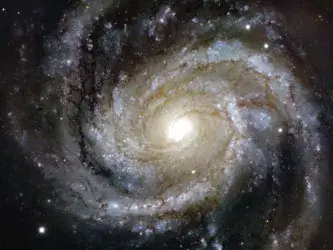The challenge of global justice now
by Anthony Lewis
Compassion & terror
by Martha C. Nussbaum
World governance: beyond utopia
by Stanley Hoffmann
What human rights mean
by Charles Beitz
The limits of idealism
by Jack Goldsmith & Stephen D. Krasner
Coercive justice
by Jean Bethke Elshtain
Atrocity & legalism
by Gary J. Bass
Everyday global governance
by Anne-Marie Slaughter
The case for a UN force
by Carl Kaysen & George Rathjens
Poetry & Fiction
The Institute
by John Hollander
Exchanges
by Mary Morris
Notes
on the age of the universe
by Wendy L. Freedman
on failures of freedom & the fear of science
by Daniel C. Dennett
on poetry & the idea of nature
by Bonnie Costello
Image:
The spiral galaxy Messier 100 is one of the brightest members of the Virgo Cluster, which is the closest cluster of galaxies to our galaxy, the Milky Way, containing more than two thousand spiral, elliptical, and irregular galaxies. Embedded within its majestic spiral arms are myriads of newly formed stars, some of which are the rare, luminous stars known as Cepheid variables. This picture is a combination of images from the FORS instrument on ESO’s Very Large Telescope at Paranal Observatory in Chile, taken with red (R), green (V) and blue (B) filters. Image courtesy of the European Southern Observatory.
A true color image of Messier
100 (M100), a spiral galaxy within the nearest
massive cluster of galaxies, the Virgo cluster.
Embedded within its majestic spiral arms are
myriads of newly formed stars, some of which
are the rare, luminous stars known as Cepheid
variables. The high resolution afforded by the
Hubble Space Telescope allows astronomers to
measure Cepheids to much greater distances
than previously possible. See Wendy L. Freedman on The age of the universe, pages 122–126.
Image © nasa and Space Telescope Science Institute (stsci).
Image:
The spiral galaxy Messier 100 is one of the brightest members of the Virgo Cluster, which is the closest cluster of galaxies to our galaxy, the Milky Way, containing more than two thousand spiral, elliptical, and irregular galaxies. Embedded within its majestic spiral arms are myriads of newly formed stars, some of which are the rare, luminous stars known as Cepheid variables. This picture is a combination of images from the FORS instrument on ESO’s Very Large Telescope at Paranal Observatory in Chile, taken with red (R), green (V) and blue (B) filters. Image courtesy of the European Southern Observatory.
A true color image of Messier
100 (M100), a spiral galaxy within the nearest
massive cluster of galaxies, the Virgo cluster.
Embedded within its majestic spiral arms are
myriads of newly formed stars, some of which
are the rare, luminous stars known as Cepheid
variables. The high resolution afforded by the
Hubble Space Telescope allows astronomers to
measure Cepheids to much greater distances
than previously possible. See Wendy L. Freedman on The age of the universe, pages 122–126.
Image © nasa and Space Telescope Science Institute (stsci).

